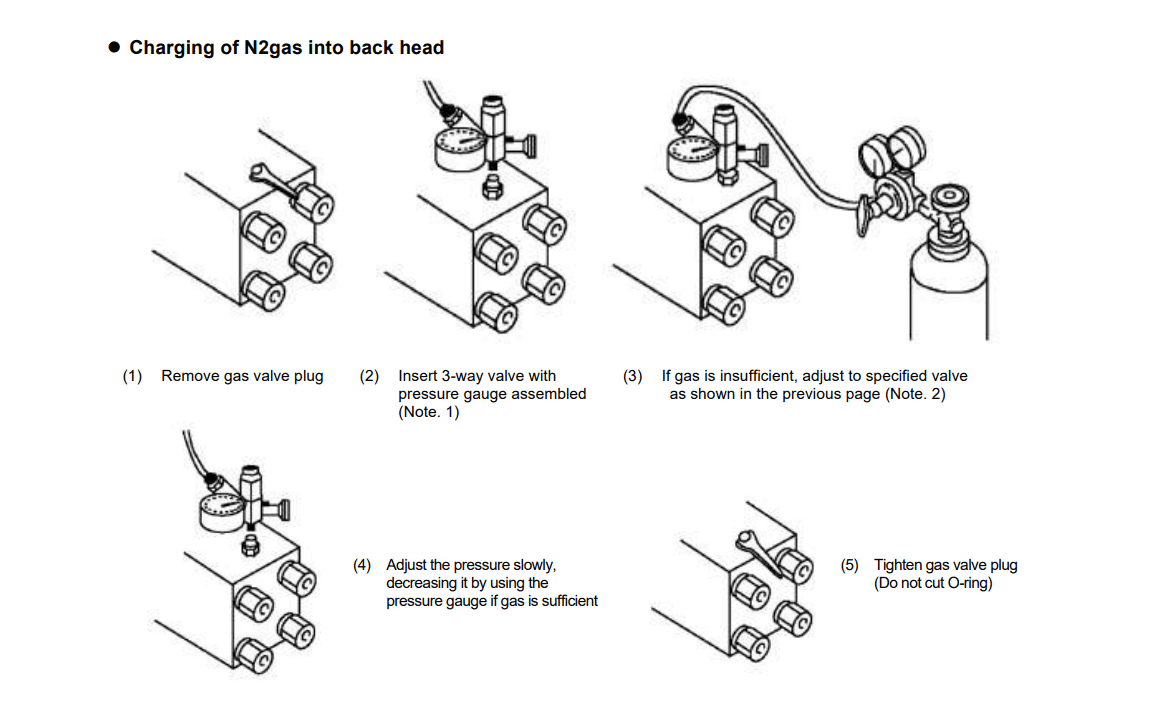Why Nitrogen Charging Matters for Hydraulic Breakers and How to Do It
Properly charging nitrogen is a critical maintenance practice for hydraulic breakers. However, many operators are unaware of the correct nitrogen amount to add or the proper procedure. This guide covers why nitrogen charging is important, potential issues from improper levels, and how to charge nitrogen correctly.


Why Nitrogen Charging Is Important for Hydraulic Breakers
One essential component that relies on nitrogen is the accumulator. It is filled with nitrogen to store residual energy from previous blows and piston recoil. During the next strike, this stored energy is released simultaneously, boosting the striking power.
Simply put, nitrogen enhances impact energy, directly affecting the performance of the hydraulic breaker. Maintaining the correct nitrogen level is critical for optimal operation and efficiency.
What Happens When Nitrogen Is Insufficient?
Reduced Pressure: Low nitrogen levels cause decreased accumulator pressure, resulting in weaker striking force.
Damaged Diaphragm: Insufficient nitrogen can lead to diaphragm damage, requiring complex and costly maintenance involving complete disassembly.
To avoid these issues, it's essential to maintain the specified nitrogen pressure.
What Happens When Nitrogen Is Overcharged?
Adding excessive nitrogen is not beneficial and can cause severe problems:
Excessive Pressure: If the nitrogen pressure is too high, the hydraulic oil cannot push the cylinder rod upward to compress the nitrogen.
Energy Storage Failure: The accumulator cannot store energy properly, rendering the hydraulic breaker non-functional.
Maintaining nitrogen pressure within the recommended range of 14-15 MPa is essential for optimal performance.
Excavator Breaker Nitrogen Charging Guide
Follow these steps to ensure safe and effective nitrogen charging:
Step 1: Remove the Nitrogen Filling Screw
Unscrew and remove the nitrogen filling screw from the breaker.
Step 2: Install the Pressure Gauge
Attach the pressure gauge to the nitrogen filling hole.
Tighten it securely.
Step 3: Connect the Nitrogen Filling Pipe
Attach one end of the nitrogen filling pipe to the pressure gauge.
Ensure the connection is tight.
Step 4: Prepare the Nitrogen Tank
Use a wrench to remove the cap from the nitrogen tank.
Step 5: Connect to the Nitrogen Bottle
Attach the other end of the nitrogen filling pipe to the nitrogen bottle.
Tighten the connection with a wrench.
Step 6: Charge the Nitrogen
Open the valve switch on the nitrogen bottle.
Press the yellow button on the pressure gauge to release nitrogen into the breaker.
Recommended Pressure Range: 14-15 MPa.
Step 7: Safety Precautions
Keep pressure within 14-15 MPa.
Exceeding 15 MPa may damage the breaker.
Before disconnecting, release excess nitrogen to ensure safe disassembly.

Note:
- Insert 3-way valve after its handle is fully turned counterclockwise.
- Turn the 3-way valve handle clockwise slowly. Stop turning it when the needle of the gauge starts to move. If it is turned clockwise too tightly, the valve may easily be damaged. Pay special attention to ensure that the nitrogen gas is not charged excessively.
Conversion table for charging nitrogen gas pressure to back head (Depends on the temperature of the back head surface)
DSBREAK (Inward Valve Type)
| Back head gas Pressure | Ambient Temperature(/) | ||||
| 0/32 | 10/50 | 20/68 | 30/88 | 40/104 | |
| kg/cm² | 15.5 | 15.9 | 16.3 | 16.8 | 17.3 |
| psi | 220 | 226 | 231 | 238 | 246 |
Conclusion
Regular nitrogen charging is essential for maintaining your hydraulic breaker’s performance and longevity. Keeping nitrogen levels within the recommended pressure range (14-15 MPa) ensures optimal operation, preventing damage and costly repairs. Following the step-by-step nitrogen charging guide provided here will help you achieve consistent and powerful striking force.
Remember, proper maintenance of your hydraulic breaker leads to improved efficiency and extended service life. Keep your equipment performing at its best by following the correct nitrogen charging procedures.


 sales@wxbychina.com
sales@wxbychina.com








 HOME
HOME ABOUT
ABOUT PRODUCTS
PRODUCTS CASES
CASES VIDEOS
VIDEOS